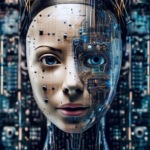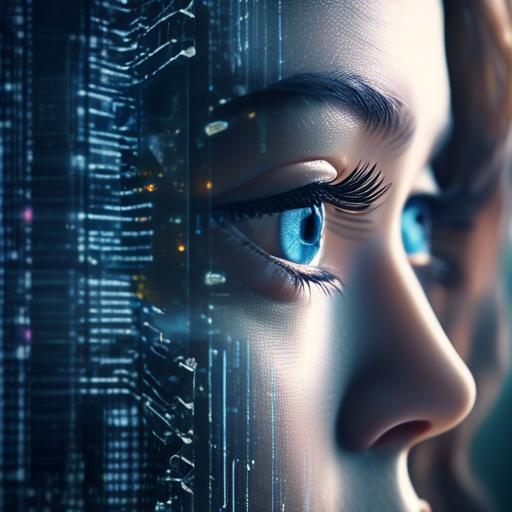In a world where reality can be effortlessly reconstructed with pixels and algorithms, the line between truth and illusion becomes intertwined in the vast digital tapestry of human experience. Enter the burgeoning realm of deepfakes—digitally manipulated images and videos that blur the boundaries between what is real and what is fabricated. As we embrace the marvels of AI image generators capable of producing breathtaking visuals, we must also confront the shadows they cast. Addressing these deepfake concerns is not only about safeguarding truth but also about preserving the trust upon which our digital interactions are built. In this article, we embark on a journey through the virtual and the visceral, exploring how technology can be both the artist and the arbiter, ensuring that authenticity remains the cornerstone of our digital lives. Join us as we delve into the innovative solutions and collaborative efforts shaping a future where AI serves as the guardian of integrity in a world of endless possibilities.
Table of Contents
- Understanding the Rise of Deepfakes in the Digital Age
- Harnessing AI: The Solution Within the Problem
- Analyzing the Ethical Implications and Responsibilities
- Strengthening Detection Through Advancements in AI Technology
- Fostering Public Awareness and Media Literacy
- Regulatory Frameworks: Safeguarding Against Deepfake Threats
- Encouraging Collaboration Between Tech Giants and Policymakers
- Promoting Innovation for a Secure Digital Future
- In Conclusion
Understanding the Rise of Deepfakes in the Digital Age
In an era where visuals have become a primary mode of communication, the proliferation of deepfakes has raised a multitude of ethical and practical concerns. Deepfake technology utilizes AI to produce remarkably realistic images, videos, and audio that can be virtually indistinguishable from authentic content. The potential for misuse is vast, from creating sensationalist fake news to manipulating public opinion or even enabling identity theft.
To combat the growing threat posed by deepfakes, AI image generators have emerged as a powerful tool. They function by leveraging advanced machine learning algorithms to analyze, detect, and even create synthetic media. These generators can help in several ways:
- Verification: AI image generators can assist in verifying the authenticity of media content, cross-referencing it with known datasets to identify manipulations.
- Education: They serve as educational tools, helping users understand the mechanics of deepfakes and how to spot them.
- Creative Solutions: Leveraging their capabilities, individuals and organizations can create AI-generated content that is ethical and transparent.
AI image generators also play a pivotal role in research and training. Numerous platforms now incorporate these tools for educational purposes, ensuring that future generations of journalists, content creators, and digital citizens are well-informed about the nuances of digital media.
| Feature | Benefit |
|---|---|
| Content Verification | Ensures media authenticity |
| Public Awareness | Educates on fake detection |
| Ethical Creation | Promotes integrity in media |
While the rise of deepfakes poses serious challenges, it also opens a dialogue about digital ethics and the future of media. By incorporating AI image generators, there is an opportunity not only to address the current concerns but also to innovate and shape a more transparent digital landscape.
Harnessing AI: The Solution Within the Problem
The rise of **deepfakes** has sparked both fascination and concern across the digital landscape. However, within this complex problem lies an intriguing solution: utilizing AI image generators to counteract the very threat they pose. AI holds the potential not only to create hyper-realistic images but also to detect and debunk them.
AI-powered image generators can serve as **defensive tools** against deepfakes by enabling quick and precise analysis of questionable content. These sophisticated algorithms can differentiate between genuine images and manipulated ones with remarkable accuracy. This functionality empowers platforms and individuals to maintain a high level of integrity and trust in visual media.
- Verification: AI tools can compare images against a database of known authentic visuals to identify alterations.
- Consistency Checking: They can analyze minute inconsistencies in lighting, shadows, and reflections that typically escape the human eye.
- Trace Origins: AI can track the origins of an image to verify its authenticity, relying on metadata and digital signatures.
Moreover, open-source AI projects are evolving rapidly, providing accessible solutions for detecting deepfakes. These community-driven initiatives foster collaboration and development, ensuring that the battle against digital fabrications is robust and ongoing. Here’s a brief comparison of some accessible solutions:
| AI Tool | Key Feature | Accessibility |
|---|---|---|
| DeepWard | Detects deepfake videos | Open-source |
| FakeyFinder | Image integrity verification | Free to use |
| VeriImage | Metadata analysis | Subscription-based |
By leveraging AI’s capabilities to scrutinize content, we can make significant strides in identifying and reducing the spread of deepfakes. The road ahead may be challenging, but with a creative and community-driven approach, AI offers a promising path to preserving the trustworthiness of our visual media.
Analyzing the Ethical Implications and Responsibilities
In today’s digital age, the rise of AI image generators, while groundbreaking, brings forth a myriad of ethical concerns that cannot be overlooked. One primary issue is the creation and distribution of deepfakes, which can have serious implications for privacy, misinformation, and even personal safety. **Deepfakes** are synthetic media where a person in an existing image or video is replaced with someone else’s likeness. These can be used maliciously, leading to potential identity theft, defamation, and **breaches of trust**.
Responsibilities of Developers:
- Implementing robust safeguards to prevent the misuse of their technology.
- Ensuring that their products are compliant with current privacy laws and regulations.
- Providing clear guidelines and ethical usage policies for end-users.
It’s crucial to understand that while developing such advanced technologies, we have a moral duty to mitigate the harmful effects they may bring. Developers should be proactive in **incorporating ethical frameworks** into their design processes. This could involve creating features that can identify and label deepfakes or limiting certain functionalities that might be easily exploited for nefarious purposes.
| Action | Benefit |
|---|---|
| Incorporate deepfake detection tools | Enhances credibility and user trust |
| Adopt ethical guidelines | Reduces legal risks and promotes responsible usage |
| Educate end-users | Minimizes chances of misuse |
End-User responsibilities:
- Using these powerful tools in ways that respect the privacy and rights of others.
- Being vigilant about the potential for abuse and reporting any harmful use of AI-generated images.
- Remaining informed about the latest advancements in deepfake detection and prevention.
Addressing these ethical concerns effectively necessitates a collaborative approach. By fostering a community that values both innovation and responsibility, we can enjoy the benefits of AI image generators while minimizing the risks associated with deepfakes. End-users, developers, and policymakers all have a role to play in shaping a digital future that upholds ethical integrity.
Strengthening Detection Through Advancements in AI Technology
Deepfakes present a growing challenge in the digital landscape, threatening the integrity of media we consume. However, leveraging breakthroughs in **AI technology** can significantly enhance our capabilities in detecting and countering these malicious creations. One of the most promising developments in this field is the deployment of AI-driven image generators for deepfake identification.
These advanced systems use deep learning algorithms to distinguish between authentic and manipulated content. AI image generators work by analyzing minute details within photos and videos, identifying telltale signs of tampering that are often imperceptible to the human eye. By cross-referencing a vast database of known images, these systems can flag inconsistencies and provide a confidence score, highlighting the probability of an image or video being a deepfake.
- **Enhanced Accuracy:** AI algorithms continually learn and adapt, improving their detection accuracy over time.
- **Speed and Efficiency:** Automated systems can process vast amounts of data swiftly, providing near-instantaneous results.
- **Accessibility:** These tools can be integrated into various platforms, making them widely accessible to both individuals and organizations.
To illustrate the effectiveness of AI in deepfake detection, consider the following comparison of manual detection versus AI-assisted methods:
| Criteria | Manual Detection | AI-Assisted Detection |
|---|---|---|
| Accuracy | Moderate | High |
| Time Required | Hours to Days | Seconds to Minutes |
| Scalability | Limited | Unlimited |
The robustness of AI detection methods lies in their ability to adapt and evolve alongside emerging deepfake techniques. By continually updating their algorithms and leveraging vast machine learning datasets, AI systems can stay one step ahead of deepfake creators. This creates a dynamic defense mechanism, positioning AI as a critical ally in the fight against digital misinformation.
Fostering Public Awareness and Media Literacy
Amid the rise of deepfakes and AI-generated images, fostering public awareness and promoting media literacy is crucial. The advancements in technology have made it easier to create convincing yet deceptive media. Therefore, understanding how to navigate and critically analyze digital content is essential for everyone.
Key Steps for Enhancing Media Literacy:
- Understand the Technology: Educate yourself on how AI image generators and deepfakes work.
- Source Verification: Always check the origin of the media content before believing or sharing it.
- Tools and Resources: Utilize available tools designed to detect deepfakes and manipulated images.
- Critical Thinking: Encourage critical analysis of content by questioning its authenticity and intent.
Ensuring a well-informed public means equipping people with the knowledge to identify potential misinformation. An effective approach is to integrate media literacy into educational curricula, empowering students from a young age to discern genuine from fabricated content.
To aid in this initiative, consider the following comparisons:
| Aspect | Deepfake | Legitimate Content |
|---|---|---|
| Authenticity | AI-generated, often deceptive | Originates from verified sources |
| Purpose | Can be malicious or satirical | Informative or entertainment purposes |
| Verification | Difficult to verify without tools | Can be cross-referenced easily |
Promoting initiatives such as workshops, webinars, and public discussions on the impact and detection of deepfakes can significantly enhance community resilience against misinformation. Additionally, supporting media outlets and social media platforms in implementing policies to combat the spread of deepfakes is paramount.
By taking these steps, we can collectively cultivate a more discerning and media-savvy society, capable of navigating the complexities of the digital age with confidence and care.
Regulatory Frameworks: Safeguarding Against Deepfake Threats
In a world increasingly menaced by the insidious capabilities of deepfake technology, regulatory frameworks are our frontline defense. Governments around the globe are spearheading initiatives to halt the malicious use of AI image generators, ensuring a safe digital environment for all. These measures include a variety of proactive regulations aimed at both deterring potential misuse and offering recourse when it does occur.
Key regulatory measures include:
- Mandatory Disclosure: Laws requiring creators to clearly label AI-generated content.
- Legal Accountability: Fines and criminal charges for those caught distributing harmful deepfakes.
- Verification Protocols: Tools for validating the authenticity of digital media.
At the international level, bodies like the European Union are pushing for comprehensive legislation under acts like the Digital Services Act (DSA) and the Artificial Intelligence Act. These regulations not only target individual perpetrators but also hold tech companies accountable, demanding transparency and cooperation in dismantling this digital menace.
In parallel, technology firms have stepped up by developing sophisticated detection algorithms that can identify deepfakes with remarkable accuracy. Augmenting these efforts, public-private partnerships are flourishing, combining the agility of private companies with the oversight of governmental bodies. This synergistic approach ensures that the fight against deepfakes remains adaptive and resilient.
| Entity | Action |
|---|---|
| Government | Legislating and enforcing deepfake laws |
| Tech Firms | Developing detection technologies |
| Public-Private Partnerships | Coordinating efforts for greater impact |
By combining legal safeguards with cutting-edge technology, we can forge a robust defense mechanism against the rising tide of deepfake threats. Collaboration across sectors and borders is pivotal to maintaining the integrity of our digital spaces, ensuring that innovation serves as a force for good rather than harm.
Encouraging Collaboration Between Tech Giants and Policymakers
To tackle the complex issue of deepfake concerns effectively, fostering active collaboration between tech giants and policymakers is essential. This union can leverage the strengths of both entities to create robust solutions. Tech companies possess the technical know-how to design sophisticated AI image generators that can detect and combat deepfakes, while policymakers can establish guidelines and ethical frameworks to govern the usage of these technologies.
Steps to Encourage Successful Collaboration:
- Regular Joint Meetings: Establish frequent dialogues between tech experts and policymakers to stay updated on emerging threats and advances in technology.
- Shared Research Initiatives: Fund collaborative research projects focused on developing AI systems capable of identifying and mitigating deepfakes.
- Ethical Guidelines: Develop a set of ethical standards that guide the development and deployment of AI to ensure it is used responsibly.
Creating a shared platform for continuous education and awareness is also vital. Tech companies can offer training sessions for policymakers to help them understand the intricacies of AI technologies and their potential misuse. In return, policymakers can provide insights into legal and ethical considerations, ensuring that technological advances do not outpace legislation.
| Action | Tech Giants’ Role | Policymakers’ Role |
|---|---|---|
| Research | Innovation in AI detection tools | Funding and ethical guidance |
| Legislation | Technical consulting | Establishing regulations |
| Public Awareness | Develop educational content | Spearhead public campaigns |
Integrating diverse perspectives through cross-industry collaboration can lead to more comprehensive solutions. By combining the technical proficiency of tech giants with the regulatory experience of policymakers, society can cultivate an environment where AI image generators are used ethically and responsibly. This multifaceted approach ensures that the fight against deepfakes is not only technological but also human-centered and principled.
Promoting Innovation for a Secure Digital Future
In recent years, the rise of deepfake technology has posed significant challenges to digital security and public trust. To combat this, cutting-edge **AI image generators** have emerged as powerful tools, offering a dual approach of creating authentic imagery and detecting manipulations. These generators leverage advanced algorithms to ensure we remain a step ahead in the fight against digitally altered content.
Beyond their immediate application in security, AI image generators encourage **creative expression** and innovation in various fields:
- Media and Entertainment: Crafting realistic visual effects and avatars.
- Marketing: Personalized ad creation tailored to specific audiences.
- Education: Developing immersive learning experiences.
While the benefits are enormous, ethical and practical use-cases must be prioritized. Developers and users need to collaborate, setting guidelines that minimize misuse. A collaborative approach ensures these tools contribute to **public trust** and safety rather than undermining it.
To illustrate the stark contrast between deepfakes and genuine AI-generated content, refer to the table below:
| Aspect | Deepfake | Authentic AI-Generated Image |
|---|---|---|
| Intent | Manipulative | Creative/Security |
| Quality | Often imperceptible alterations | High-quality, verifiable content |
| Public Trust | Undermines trust | Builds trust |
Empowering individuals and organizations with the knowledge and tools to distinguish between these forms of content is crucial. By advancing AI image generation technologies with a focus on ethical standards and robust applications, we can foster an environment where innovation thrives without compromising security.
In Conclusion
As we navigate the ever-evolving landscape of technology and its potential impacts on society, it is important to address deepfake concerns with a sense of responsibility and vigilance. By harnessing the power of AI image generators, we have the opportunity to not only detect and mitigate the risks of deepfake manipulation, but also to empower individuals to protect themselves and their digital identities. Let us continue to work together towards a safer and more secure future, where trust and authenticity prevail. Remember, with the right tools and mindset, we can rise above any challenges that come our way. Stay informed, stay alert, and together, we can tackle any deepfake concerns that may arise. Thank you for joining us on this journey of innovation and progress.






























